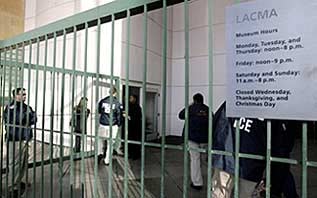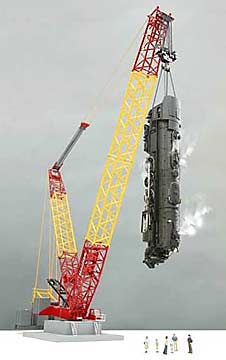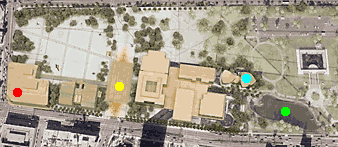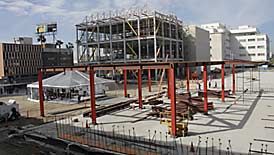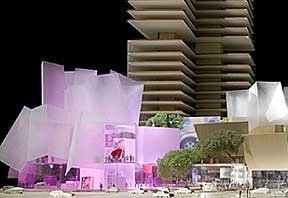L.A.’s MOCA in Meltdown
It appears that MOCA Director Jeremy Strick and the museum trustees are guilty of a total failure of leadership - not to mention the gross mismanagement of the world famous museum. As a nonprofit institution, MOCA collects little government funding and instead relies on donors for some 80% of its expenses. By checking the GuideStar website, which keeps track of nonprofits and their donors, it has come to light that Strick has a salary of $500,000. Readers should be reminded that the annual compensation of the president of the United States is $400,000. Strick also pays at least five higher-ranking MOCA employees six figure salaries. Furthermore, the Board of MOCA loaned Strick over $500,000 for the purchase of a house - all at a time when the museum is tottering on total financial collapse.
In his Open letter to MOCA’s board of trustees, L.A. Times art critic Christopher Knight puts the blame for MOCA’s crisis squarely upon Director Jeremy Strick as well as the museum’s trustees; "As trustees your first responsibility is fiduciary, and in that you have been a flop". Knight went on to disparage the supposed "rescue plans" being considered to save the museum as "shameful". The irate art critic made the following comments about the proposed rescue strategies:
"One would rent your incomparable painting and sculpture collection to a local foundation - controlled by one of your own trustees! - in exchange for some sort of multimillion-dollar annuity. The other would be a flat-out sale of it to another museum, so that you might shift the fundraising burden elsewhere, take the revenue and continue as an exhibition-only venue.Apparently the Armageddon option has been selected. On the Los Angeles Times arts blog, Knight stated; "(....) here is what I'm told the board is now prepared to do: formally approach the Los Angeles County Museum of Art about a merger, which will effectively mean a transfer of MOCA's extraordinary collection to the Mid-Wilshire complex."
Yes, we live in a market economy, where art is bought and sold; but one of the glories of an art museum is that it provides refuge from the crude commercial world. When art enters a museum's permanent collection, it leaves the marketplace behind. That your first instinct is apparently scheming to monetize your extraordinary collection shows that you are not trustees, you are art dealers in disguise.
The third plan I've been told about is even worse - total Armageddon. A merger with the Los Angeles County Museum of Art, in which the collection and selected staff would move to the Mid-Wilshire campus and the downtown facilities would close, would mean MOCA would cease to exist. You seem to be willing to allow your own institution, one whose remarkable program and astounding collection are the envy of cities around the world, to simply disappear. Dumbfounding."
To be honest, I have never been enamored of MOCA. True enough, it houses notable works from the likes of Arshile Gorky, Robert Rauscheberg, Jackson Pollock, and others; and in 2003 it did present a wonderful retrospective of paintings by Lucian Freud. But as of late MOCA has advanced pointless and vacuous works that tell us nothing about the human condition, witness the loathsome Takashi Murakami. To survive as a viable institution, which seems doubtful at this point, MOCA’s continued existence depends on more than just massive infusions of capital - it requires a new vision. That being said, I take no particular delight in seeing one of the major art museums of my city going to ruin.
MOCA's dilemma is indicative of the crisis now rippling through the world of elite art institutions, a disaster that will only intensify as late capitalism careens into worldwide depression. But the problem is much more than just financial, it is one of art and culture having reached an aesthetic and political impasse. Breaking through that dead-end to reach the transformative and liberating will be necessary if the crisis in contemporary art is to be resolved.
UPDATES:
Dec. 23, 2008. In its article, MOCA accepts Broad’s lifeline, the Los Angeles Times reports that MOCA has voted to accept a $30-million bailout offered by billionaire Eli Broad (whose name rhymes with "load"). Additionally, MOCA's director Jeremy Strick has resigned and the ailing museum has appointed UCLA Chancellor Emeritus Charles E. Young as its CEO. Acceptance of the Broad offer ends speculation that MOCA might merge with the Los Angeles County Museum of Art.
Bloomberg.com reports that in a Dec. 23 joint statement made by MOCA and the Broad foundation, Mr. Broad said; "It is in the best interest of the city for MOCA to remain independent." There is more irony to be found in that remark than in all of the postmodern art found in MOCA’s collection. In 2007 Broad was ranked by FORBES as number 42 on its list of 400 richest Americans - with an estimated net worth of over $5.8 billion. He is also the founding chairman of MOCA, and his bailout of the institution should be seen in that context. Broad is also chair of the Los Angeles Grand Avenue Authority, which plans a $1.8 billion "improvement" of the downtown area where MOCA is located.
Nov. 21, 2008. A spokeswoman for MOCA released the following statement: "MOCA has received a letter from the California attorney general's office. The California attorney general has broad jurisdiction and oversight over California nonprofits, including MOCA. The letter requested information and documents related to the museum's finances. MOCA is fully cooperating with the attorney general." So far the office of the attorney general has not commented on its investigation of the museum.
Labels: Eli Broad, Postmodernism-Remodernism
